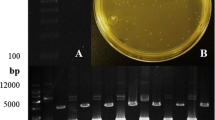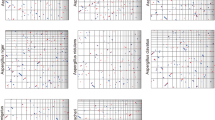Abstract
Selected endophytic fungi have been report to be inulin degraders to produce fructose or other oligosaccharides. In this study, the Aspergillus sp. producing inulinase were isolated from selected plant species at Serdang area in Malaysia. Fungal isolates were screened solely based on inulin degrading enzymes production and two isolates named Asf1 and Onf1 were selected as the best inulinase enzyme producers. Genomic DNA of these two isolates were extracted and amplified by polymerase chain reaction (PCR). A 1,341 bp DNA fragment containing inulinase gene was successfully amplified from Asf1 fungal isolate and was named as inu2 gene in this study. Based on the morphological characteristics, rDNA and neighbour-joining phylogenetic analysis, Asf1 fungal isolate could display closely-related to the genus of Aspergillus. The complete sequence designated Asf1 Inu2 gene was successfully obtained via rapid-amplification of cDNA ends-polymerase chain reaction (RACE-PCR). A 2.3 kb DNA fragment encoding endoinulinase, inu2, from Asf1 fungal isolate includes an open reading frame of 1,552 bp with calculated molecular weight of 55,954.1 Da and signal peptide sequence of 23 amino acids. The deduced amino acid sequence of the Asf1 inu2 displayed 97, 96, 69 and 22% identities to that of A. ficuum inu2, A. niger inuB, P. purpurogenum and K. marxianus, respectively. Phylogenetic analysis showed that fungal endo- and exo-inulinases have indepently evolved with the respective hydrolytic activities toward terminal and internal β-(2 → 1)-fructofuranosidic linkages in inulin.








Similar content being viewed by others
References
Cabral D, Stone J, Carroll GC (1993) The internal mycoflora of Juncus spp.: microscopic and cultural observation of infection pattens. Mycol Res 97:367–376
Chi Z, Chi Z, Zhang T, Liu G, Yue L (2009) Inulinase-expressing microorganisms and applications of inulinases. Appl Microbiol Biotechnol 82:211–220
Chomczynski P, Sacchi N (1987) Single-step method of RNA isolation by acid guanidinium thiocyanate-phenol-chloroform extraction. Anal Biochem 162:156–159
Dams E, Hendricks L, Van de Peer Y, Neefs J, Smits G, Vandenbempt I, De Wachter R (1988) Compilation of small ribosomal subunit RNA sequences. Nucleic Acids Res 16:87–173
Guillermo R, Castro Mario D, Baigori FS (1995) A plate technique for screening of inulin degrading microorganisms. J Microbiol Meth 22:51–56
Guo LD, Hyde KD, Liew ECY (2000) Identification of endophytic fungi from Livistona chinensis based on morphology and rDNA sequences. New Phytology 147:617–630
Hazalin NA, Ramasamy K, Lim SM, Abdul Wahab I, Cole ALJ, Abdul Majeed AB (2009) Cytotoxic and antibacterial activities of endophytic fungi isolated from plants at the National Park, Pahang, Malaysia. BMC Complem Altern Med 9:1–5
Hyde KD, Soytong K (2008) The fungal endophyte dilemma. Fungal Divers 33:163–173 Biochemical and Biophysical Research Communications 371:600–605
Lacap DC, Liew ECY, Hyde KD (2003) An evaluation of the fungal ‘morphotype’ concept based on ribosomal DNA sequences. Fungal Divers 12:53–66
Lopez-Molina D, Navarro-Martınez MD, Melgarejo FR, Hiner NP, Chazarra S, Rodrıguez-Lopez JN (2005) Molecular properties and prebiotic effect of inulin obtained from artichoke (Cynara scolymus L.). Phytochemistry 66:1476–1484
Miller GL (1959) Use of dinitrosalicylic acid reagent for determination of reducing sugar. Anal Chem 31:426–428
Nagem RA, Rojas AL, Golubev AM, Korneeva OS, Eneyskaya EV, Kulminskaya AA, Neustroev KN, Polikarpov I (2004) Crystal structure of exo-inulinase from Aspergillus awamori: the enzyme fold and structural determinants of substrate recognition. J Mol Biol 344:471–480
Ohta K, Akimoto H, Matsuda S, Toshimitsu D, Nakamura T (1998) Molecular cloning and sequence analysis of two endoinulinase genes from Aspergillus niger. Biosci Biotechnol Biochem 62:1731–1738
Ohta K, Suetsugu N, Nakamura T (2002) Purification and properties of an extracellular inulinase from Rhizopus strain TN-96. J Biosci Bioeng 94:78–80
Ohta K, Akimoto H, Moriyama S (2004) Fungal inulinases: enzymology, molecular biology and biotechnology. J Appl Glycosci 51:247–254
Onodera S, Murakami T, Ito Ha, Mori H, Matsui H, Honma M, Chiba S, Shiomi N (1996) Molecular cloning and nucleotide sequences of cDNA and gene encoding endo-inulinase from Penicillium purpurogenum. Biosci Biotechnol Biochem 60:1780–1785
Pons T, Olmea O, Chinea G, Beldarrain A, Marquez G, Acosta N, Rodriguez L, Valencia A (1998) Structural model for family 32 of glycosyl-hydrolase enzymes. Proteins 33:383–395
Qi ZT, Kong HZ (1997) Flora Fungorum Sinicorum-Aspergillus et Teleomorphi Cognati. Science Press, Beijing
Regina MM, Gern Sandra A, Furlan Jorge L, Ninow JR (2001) Screening for microorganisms that produce only endo-inulinase. Appl Microbiol Biotechnol 55:632–635
Rocha JR, Catana R, Ferreira BS, Cabral JMS, Fernandes P (2006) Design and characterisation of an enzyme system for inulin hydrolysis. Food Chem 95:77–82
Sharma AD, Kainth S, Gill PK (2006) Inulinase production using garlic (Allium sativum) powder as a potential substrate in Streptomyces sp. J Food Eng 77:486–491
Shen P, Fan XR, Li GW (2000) The experiment of microbiology, 3rd version. Publishing House of High Education, Beijing
Singh P, Gill PK (2006) Production of inulinases: recent advances. Food Technol Biotechnol 44:151–162
Singh RS, Dhaliwal R, Puri M (2006) Production of inulinase from Kluyveromyces marxianus YS-1 using root extract of Asparagus racemosus. Process Biochem 41:1703–1707
Skowronek M, Fiedurek J (2004) Optimisation of inulinase production by Aspergillus niger using simplex and classical method. Food Technol Biotechnol 42:141–146
Strobel G, Yang X, Sears J, Kramer R, Sidhu R, Hess W (1996) Taxol from Pestalotiopsis microspora, an endophtic fungus of Taxus wallachiana. Microbiology 142:435–440
Tamura K, Dudley J, Nei M, Kumar S (2007) MEGA4: molecular evolutionary genetics analysis (MEGA) software version 4.0. Mol Biol Evol 24:1596–1599
Thompson JD, Higgins DG, Gibson TJ (1994) CLUSTAL W: improving the sensitivity of progressive multiple sequence alignment through sequence weighting, position-specific gap penalties and weight matrix choice. Nucleic Acids Res 22:4673–4680
Uhm TB, Chae KS, Lee DW, Kim HS, Cassart JP, Vandenhaute J (1998) Cloning and nucleotide sequence of the endoinulinase-encoding gene, inu2, from Aspergillus ficuum. Biotechnol Lett 20:809–812
Vandamme EJ, Derycke DG (1983) Microbial inulinases: fermentation process, properties and application. Adv Appl Microbiol 29:139–176
Von Gromoff ED, Treier U, Beck CF (1989) Three light-inducible heat shock genes of Chlamydomonas reinhardtii. Mol Cell Biol 9:3911–3918
Wen T, Liu F, Huo K, Li YY (2003) Cloning and analysis of the inulinase gene from Kluyveromyces cicerisporus CBS4857. World J Microbiol Biotechnol 19:423–426
White TJ, Bruns TD, Lee S, Taylor JW (1990) Amplification and direct sequencing of fungal ribosomal RNA genes for phylogenetics. In: Innis MA, Gelfand DH, Sninsky JS, White TJ (eds) PCR protocols: a guide to methods and applications. Academic Press, New York, pp 315–322
Zhang L, Wangjing OY, Wang Y (2003) Expression of the inulinase gene from Aspergillus niger in Pichia pastoris. Process Biochem 38:1209–1212
Zhang L, Zhao C, Zhu D, Ohta Y, Wang Y (2004) Purification and characterization of inulinase from Aspergillus niger AF10 expressed in Pichia pastoris. Protein Expr Purif 35:272–275
Zhang T, Gong F, Chi Z, Liu G, Chi Z, Sheng J, Li J, Wang X (2009) Cloning and characterization of the inulinase gene from a marine yeast Pichia guilliermondii and its expression in Pichia pastoris. Antonie van Leeuwenhoek 95:13–22
Zhihong W, Yoshihiko T, Blomquist X-RW (2003) 18S rRNA gene variation among common airborne fungi, and development of specific oligonucleotide probes for the detection of fungal isolates. Appl Environ Microbiol 69:5389–5397
Zhu YY, Machleder EM, Chenchik A, Li R, Siebert P (2001) Reverse transcriptase template switching: a SMARTTM approach for full-length cDNA library construction. Biotechnology 30:892–897
Acknowledgments
This study was supported under the Malaysian IRPA program No. 09-02-04-0892-EA001.
Author information
Authors and Affiliations
Corresponding author
Rights and permissions
About this article
Cite this article
Raba’atun Adawiyah, S., Shuhaimi, M., Mohd Yazid, A.M. et al. Molecular cloning and sequence analysis of an inulinase gene from an Aspergillus sp. World J Microbiol Biotechnol 27, 2173–2185 (2011). https://doi.org/10.1007/s11274-011-0683-9
Received:
Accepted:
Published:
Issue Date:
DOI: https://doi.org/10.1007/s11274-011-0683-9




